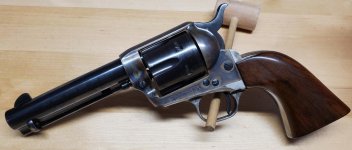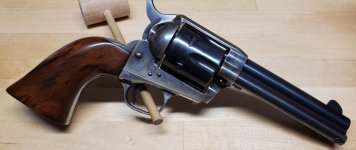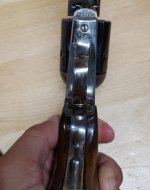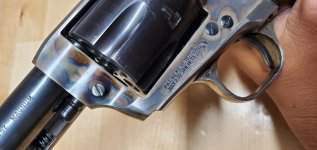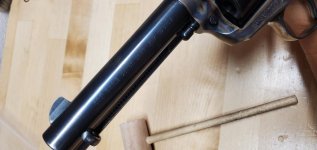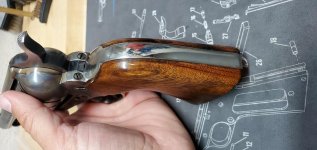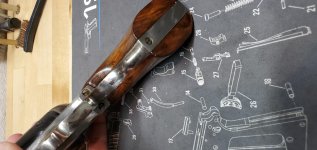The one piece grips are likely aftermarket made and not Colt mfg original to the gun. Just my opinion of course
I would suspect that whoever made the grips used the gun as the pattern and as carefully as possible shaped them to the grip frame. But in doing so it is nearly impossible not to scratch the metal and that beautiful Colt polish & blue.
So,,the end result is that the metal does end up with a few scratches or worse.
What to do...
In a lot of instances on a $125 gun which these were in the time they were retailed in the early 60's,,the workman mearly went on and sanded the grips to a nice fit right to the metal.
Then when done went one step further and polished the metal (the two piece trigger guard and backstrap) to a high polish, buffed it and let it go at that.
The contrast was 60's and 70's right in style and all was well in gun-land.
The pics make it look like there may have been some cold blue on the parts at one time,,a blue'ish' tone to some of the surfaces. But it may just be the pics.
Touch a dot of cold blue to the surfaces that you think may be nickel plated. If they are just high polished raw steel,,they'll take the cold blue.
If actually plated, it won't blue.
Either way, the backstrap and trigger guard if orig to the gun should be ser#'d on the inside of the straps along the left side edge generally.
Remove the bottom screw,,then the two screws on the top on either side of the hammer.
Then carefully pull the backstrap WITH the grip assembly as one piece straight to the rear and off of the gun.
That'll leave the trigger guard still attached to the frame with the main spring in place with it's attachmnet screw into the lower end on the tang.
The one piece grip is pulled forward off of the backstrap to remove it...or the backstrap itself is pull back out of the grip assembly.
Many are fitted by bedding the backstrap into the wood grip with fiberglas bedding compound. They fit extremely tight, so careful attention to the grips is needed to separate the two.
You can't get too rough with them
The 'one piece grip' is often 2 separate grip panels with a separate smaller spacer glued in place in betw the two to take up the space but shaped to still allow room for the mainspring.
The Originals were made of 'one piece' routed out and fitted to the backstrap and trigger guard.
On a restoration, the gun probably was shipped with 'Black Hard Rubber' checkered grips. Maybe w/the Eagle pattern. These would have been plastic by the 60's but often still listed as Hard Rubber'
Plain checkered, or, Eagle Pattern Checkered,,different grips.
Plain wooden grips also a possibility,,both 2 piece (with transverse screw),,,maybe, just maybe a one piece grip as you now have.
A Factory letter MAY tell you what style of grips it was shipped with.
It should also tell you the caliber and bbl length of course.
Don't be real surprised if it was shipped as a different caliber or bbl length.
Many have been 'smithed to change those features to owners whims.
Both the factory would do the work and most any gunsmith was capable at one time of doing the job.
Lots of extra cylinders and bbls around for the SAA.
1st and 2nd Generation bbl threads match. Cyl's do match as far as the ratchets. Some changes in subtle features like front site style, lettering and placement, flute length and style, etc. All things you want to be correct when restoring. Otherwise it's money spent for nothing.
Even a 3rd gen cylinder will fit a 2nd gen gun if you change out the hand for a 3rd gen hand.
It all starts with a factory letter to tell you what you are supposed to have in hand.
Then an estimate for the work to be done and done correctly.
At that point you make the decision if it's worth it to you to do it or not.
..and it's not always about making a profit with the finished product.
Sometimes we just like to have it done..
You could always buy a big boat instead. There's a good investment for you.

